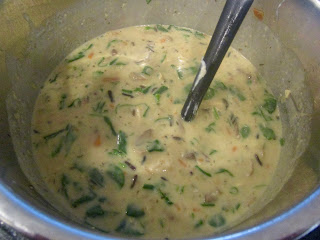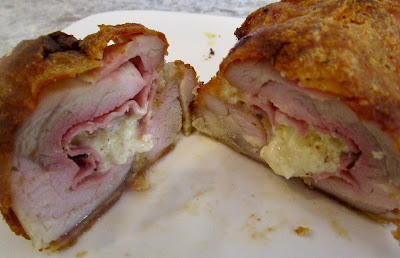I spent a lot of time the first couple days of 2020 digging through boxes looking for cookbooks and looking at a couple favorite websites and generally coming up with a list of what the first couple chicken dishes I would make for this challenge. One thing that kept popping up online - the #1 for 2019 on the NY Times Cooking site was from Alison Roman for a Vinegar Chicken with Crushed Olive Dressing, so of course I was interested in making it.
I don't actually subscribe to the NY Times online, but a quick search found the recipe elsewhere online in several places, including here.
The recipe is a simple roasted chicken seasoned with turmeric, and using the chicken drippings to make a vinaigrette with olives and herbs. Very simple but it sounded like a great week night option.
 I cross referenced Alison Roman's book, "Dining In" because the NYTimes recipe sounded similar to one in there: "Skillet Chicken with Crushed Olives and Sumac". The cooking method was a little different, but the same concept - cook chicken, add acid (lemon juice in the case of the book), finish with herbs and crushed olives. The book version of the recipe is also here.
I cross referenced Alison Roman's book, "Dining In" because the NYTimes recipe sounded similar to one in there: "Skillet Chicken with Crushed Olives and Sumac". The cooking method was a little different, but the same concept - cook chicken, add acid (lemon juice in the case of the book), finish with herbs and crushed olives. The book version of the recipe is also here. I went back and forth about which version I wanted to do and ended up doing the NY Times version, but I will also go back and do the Dining In version as a bonus recipe in the near future to compare the two versions.
 So this recipe does have a few items I didn't have in my pantry, specifically turmeric and Castelvetrano olives. Castelvetrano olives are a new one for me - apparently they are hugely popular in Italy - they are a mild, buttery brilliant green olive. I actually prefer black olives to green olives, and I had a back up plan if I couldn't find these. However, no issues there - my local grocery store had them.
So this recipe does have a few items I didn't have in my pantry, specifically turmeric and Castelvetrano olives. Castelvetrano olives are a new one for me - apparently they are hugely popular in Italy - they are a mild, buttery brilliant green olive. I actually prefer black olives to green olives, and I had a back up plan if I couldn't find these. However, no issues there - my local grocery store had them. I went with my go-to option for bone in chicken, which is a combination of legs and thighs. The ones I got were particularly hefty, so I just used 2 legs and 1 thigh, which was plenty for the two of us for dinner. The chicken is seasoned with turmeric, salt, pepper and a little olive oil, and then white wine vinegar is added to the baking dish and then roasted.
 For side dishes, I knew I wanted something that would work well with that vinaigrette - something that would absorb it, be dressed by it, be complimented by it. I decided to roast a pan of brussels sprouts, carrots, and shallots in the oven that roasted while the chicken was in the oven. I also made some quick cook faro for a grain base.
For side dishes, I knew I wanted something that would work well with that vinaigrette - something that would absorb it, be dressed by it, be complimented by it. I decided to roast a pan of brussels sprouts, carrots, and shallots in the oven that roasted while the chicken was in the oven. I also made some quick cook faro for a grain base.While the chicken is roasting, you make a simple herb salad with crushed olives, olive oil, garlic, and fresh parsley. I also had some fresh dill, so I added that as well.
 The idea is that you are basically making a vinaigrette by adding this fresh olive/herb mix to the vinegar roasted chicken.
The idea is that you are basically making a vinaigrette by adding this fresh olive/herb mix to the vinegar roasted chicken.The chicken came out a rather brilliant shade of yellow, courtesy of the turmeric. The vinegar had just about completely reduced down to nothing and there was a lot of glorious fond on the bottom of the pan. I wanted to make sure I got all that up, so I took the chicken out of the pan and added a couple extra tablespoons of white wine vinegar to the pan to deglaze the roasting pan.
At that point, you add the olive/herb/garlic mix to the pan and to make the pan sauce/vinaigrette that you pour over the chicken. The pan had the chicken fat/juices and olive oil, then there was also more olive oil in the olive/herb mix. I had already added extra vinegar to the pan to deglaze and found that the pan sauce needed quite a bit more vinegar to cut through all the richness of the fats already in the pan. I ended up adding close to another half a cup of vinegar to get a good bite to it. I thought the salt level was fine but added a couple solid grinds of black pepper.
So, how was it?
This was a really good, solid weeknight dinner. It took a grand total of about 45 minutes start to plate. I didn't feel that the turmeric brought much to the chicken other than color. I did enjoy the Castelvetrano olives more than I normally like green olives, but I'd really like to go back and try this with some of my favorite black olives (or use some Trader Joe's Olive Tapenade, which was my back up plan if I couldn't find the Castelvetranos). I'd also like to try this in warmer weather served over hearty salad with spinach and arugula.
When you look at the similarities between the NY Times recipe and the Dining In version, you can see that there's a lot of options to play around with this basic method, and that's always a win.
Overall Rating: 8 out of 10. Easy weeknight option with a lot of room to play around. Very flavorful and moist.
Ease of Preparation: 9 out of 10. Simple, easily sourced ingredients that would be easy to swap out depending on what's available in the pantry. Can't skip the fresh herbs, but could easily change up the mix used.
Will It Freezer Meal? No. There's really not much to prep ahead with this recipe and much of the recipe's success relies on that fresh vinaigrette and herb finish.
As a bonus, I also decided to make Roman's Salted Butter and Chocolate Chunk Shortbread (also here), which became a wildly popular cookie recipe when Dining In came out.
These were excellent - crisp and sweet and salty. I used my favorite blend of Trader Joe's semi-sweet chocolate and 72% chocolate, chopped by hand from their Pounder Plus bars.
I'll respectfully disagree with Roman's view of chocolate chip cookies (but then...mine also feature chocolate chunks and are sprinkled with coarse salt), but these cookies are an excellent version of shortbread. No reason not to have both in your life. I'm going to have to try making them with browned butter (also something I do for my chocolate chip cookies).
Overall Rating: 9 out of 10.
Ease of Preparation: 7 out of 10. They're a fairly standard shortbread method. I'm not a fan of doing roll and slice cookies, but I think it's the right method for these particular cookies.
Will It Freezer Meal? Absolutely. Any butter based cookie dough freezes wonderfully - I made a double batch of the dough and froze 2/3. Shape and cut your cookies but instead of baking them, put them on a sheet pan and freeze. Bag up frozen cookies and bake from frozen when you want them, adding an extra 2-3 minutes to baking time.


































